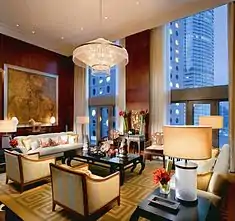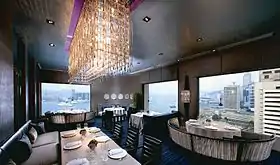Mandarin Oriental, Hong Kong
Mandarin Oriental, Hong Kong is a five-star hotel located on Connaught Road in Central, Hong Kong, owned and managed by Mandarin Oriental Hotel Group. The hotel opened in 1963 as "The Mandarin" (Most old generations of Hong Kong socialites and tycoons still refers the hotel as "The Mandarin" despite the name change). In 2005, the hotel spent US$150 million to renovate its 501 guestrooms, 10 restaurants, and numerous public spaces, as well as to construct the three-storey Mandarin Spa, one of a few Forbes Five-Star spas in Hong Kong.[2][3]
| Mandarin Oriental, Hong Kong | |
|---|---|
 | |
 Location on Hong Kong Island | |
| General information | |
| Location | 5 Connaught Road, Central, Hong Kong |
| Coordinates | 22°16′53″N 114°9′27″E |
| Opening | 1963, reopened in 2006 after a complete renovation |
| Owner | Mandarin Oriental Hotel Group |
| Management | Mandarin Oriental Hotel Group |
| Technical details | |
| Floor count | 25 |
| Design and construction | |
| Architect | Leigh & Orange[1] |
| Other information | |
| Number of rooms | 501 |
| Number of suites | 67 |
| Number of restaurants | 10 |
| Website | |
| www | |
| Mandarin Oriental, Hong Kong | |||||||||||||
|---|---|---|---|---|---|---|---|---|---|---|---|---|---|
| Traditional Chinese | 香港文華東方酒店 | ||||||||||||
| Simplified Chinese | 香港文华东方酒店 | ||||||||||||
| |||||||||||||
History
The Mandarin
Originally called The Mandarin, the hotel was built on the former site of the colonial Queen's Building on the waterfront in Central Hong Kong. From the onset, the concept was to create a hotel firmly rooted in Eastern culture, providing gracious service to a standard generally experienced only in the Asia–Pacific region.[4] The original cost of construction totalled HKD 42 million, while the interior design amounted to even 50% more at HKD 66 million, sparing no luxury or detail. John Howarth of Leigh & Orange architectural firm was hired to design the building while the interior was entrusted to Don Ashton, a Hollywood Art Director for such films as The Bridge on the River Kwai, Indiscreet, and Billy Budd.[3] The Mandarin officially opened for business in October 1963, and at 26 storeys, it was the tallest building in Hong Kong. In addition to its record-setting height, the hotel was the first in Hong Kong to have direct dial phones and the first in Asia to include a bath in every guestroom.[5] The hotel quickly drew recognition for its service and elegance, and back in 1967 was listed by Fortune magazine as one of eleven great hotels in the world.[3] The Mandarin was originally located adjacent to Victoria Harbour, but as a result of extensive land reclamation in the waterfront area, the harbour now sits several blocks away.
Mandarin Oriental Hotel Group

In 1974, the owners of The Mandarin established a hotel management company, Mandarin International Hotels Limited. The group's intention was to expand into Asia and operate hotels that would reflect the standard of service synonymous with their property in Hong Kong.[6] That same year, the company's hotel interests grew further through the acquisition of a 49 per cent interest in The Oriental, Bangkok. The Oriental, built in 1876, was already a well-known property. Through the management of both The Mandarin in Hong Kong and The Oriental, Bangkok, the Group was in an unusual position of having two "flagship" hotels whose names were among the best in hospitality. In 1985, the company rationalised its corporate structure by combining these two properties under a common name, Mandarin Oriental Hotel Group.[6]
Leslie Cheung's suicide
Famous singer, actor, and film producer Leslie Cheung committed suicide by jumping off the 24th floor of the hotel in 2003. He left behind a suicide note claiming he had suffered from depression.[7][8]
2005 renovation
The Mandarin Oriental, Hong Kong has been noted for its interior decoration.[5] In 2005, authorisation was given for a total renovation of the hotel, and when it closed in December of that year the trading floor of the stock exchange held a mock two-minute silence in memory of the hotel. For the interim period during its renovation phase, Mandarin Oriental Hotel Group launched an all-new property, The Landmark Mandarin Oriental, located in The Landmark commercial and shopping complex only a five-minute walk away, in order to continue accommodating guests without interruption. The Landmark remained open following the renovation, but maintains a distinctly more modern interior aesthetic to distinguish it from the original property.[9] After a US$150 million renovation, Mandarin Oriental, Hong Kong re-opened its doors on 28 September 2006, marking the event with a black-tie gala hosted by Dame Edna Everage with a performance by Bryan Ferry.[5] The renowned lobby, Captain's Bar, The Clipper Lounge, and Chinnery Bar remained recognisable after the renovation, but the remaining restaurants, bars, public spaces, and rooms were entirely new.[3]
Features
The hotel contains 501 guestrooms, 67 of which are suites, overlooking Victoria Harbour and the surrounding cityscape. Mandarin Oriental, Hong Kong operates ten restaurants and bars, including the Michelin-starred Pierre, Chef Pierre Gagnaire's first restaurant in Hong Kong.[10][11] Additional facilities include the three-story Mandarin Spa, indoor swimming pool, fitness centre, Mandarin Salon, and event space to accommodate functions of up to 600 people.[4]
The Mandarin Spa
The Mandarin Spa, opened in 2007, encompasses 2,100 m2 (23,000 sq ft) across three stories and incorporates an indoor swimming pool, fitness centre, holistic spa, Mandarin Salon, and Mandarin Barber. The spa draws on the established Asian healing philosophies of traditional Chinese medicine and Ayurveda. Additional features include an ice fountain, Chinese herb steam rooms, hydrotherapy, and the Kneipp pool.[2][12]
Restaurants & bars

- Pierre: a Michelin-starred restaurant serving modern French cuisine overlooking Victoria Harbour [13]
- The Mandarin Grill + Bar: a Michelin-starred restaurant contemporary European cuisine with a Crustacea bar
- Man Wah: Cantonese cuisine on the 25th floor with panoramic views of Victoria Harbour and the Hong Kong cityscape
- Café Causette: informal, all-day dining serving Asian and international cuisines
- The Krug Room: private dining overlooking the kitchens serving between ten and fourteen
- The Chinnery: named for British artist, George Chinnery, this restaurant serves traditional British cuisine and houses one of the largest collections of single malt whiskys in the region
- The Clipper Lounge: serves breakfast, lunch, and dinner buffets and an afternoon tea
- M bar: contemporary bar serving cocktails and Cantonese tapas from Pierre restaurant
- The Captain's Bar: lobby bar serving coffee in the afternoon, beer and cocktails with live music in the evening
- The Mandarin Cake Shop: retail bakery selling chocolates, cakes, breads, and afternoon coffee
References
- Mandarin Oriental, Hong Kong – The Mandarin Story. Mandarinoriental.com.
- "Archived copy" (PDF). Archived from the original (PDF) on 1 July 2017. Retrieved 17 November 2009.CS1 maint: archived copy as title (link)
- Press Kits | Mandarin Oriental Hotel Group. Mandarinoriental.com.
- Press Kits | Mandarin Oriental Hotel Group. Mandarinoriental.com.
- Jon, Peter. (10 July 2014) History of the Mandarin Oriental, Hong Kong – Articles | Travel + Leisure. Travelandleisure.com.
- Press Kits | Mandarin Oriental Hotel Group. Mandarinoriental.com.
- Apple Daily. 陳淑芬細說哥哥最後電話. Retrieved 21 March 2017.
- Corliss, R. (2003). "That old feeling: Days of being Leslie" Time magazine Asia Edition. Retrieved 17 December 2005.
- Mandarin Oriental, Hong Kong vs. The Landmark, Mandarin Oriental: Choose The Right One for You. Retrieved 28 July 2019.
- Press Kits | Mandarin Oriental Hotel Group. Mandarinoriental.com.
- Pierre | Mandarin Oriental Hotel, Hong Kong. Mandarinoriental.com.
- Press Kits | Mandarin Oriental Hotel Group. Mandarinoriental.com.
- Press Kits | Mandarin Oriental Hotel Group. Mandarinoriental.com.
External links
| Wikimedia Commons has media related to Mandarin Oriental, Hong Kong. |